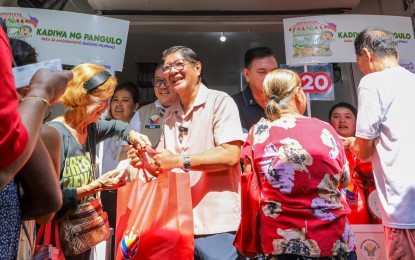
CHEAPER RICE. President Ferdinand R. Marcos Jr. leads the launch of the PHP20 per kg rice program at Zapote Public Market in Bacoor, Cavite on Wednesday (July 2, 2025). A campaign promise of the President, the PHP20/kg rice program is part of his broader agenda to address food inflation, stabilize prices and strengthen agricultural value chains. (Photo from Bongbong Marcos Facebook)
| Published July 12, 2025
MANILA, Philippines — President Ferdinand “Bongbong” Marcos Jr. has sent a strong message: the government will not back down from its signature P20-per-kilo rice program. Launched under the “Benteng Bigas Meron Na!” (BBM Na) initiative and distributed through “Kadiwa ng Pangulo” stalls, the program aims to ensure that rice remains affordable for vulnerable Filipinos such as senior citizens, solo parents, persons with disabilities, indigent families, and minimum-wage earners.
On July 6, during a vlog posted on social media, Marcos emphasized that the program is not temporary but sustainable and scalable. “P20 rice is here to stay. It is achievable; it is sustainable. Kaya abangan ninyo in your nearest public markets,” he said.
Nationwide Roll‑Out and Expansion
-
As of July 2, the initiative operates in 94 outlets nationwide, including notable expansion in Zapote Public Market in Bacoor, Cavite.
-
Figures from the Department of Agriculture report that over 105,000 families in Luzon and Visayas have already purchased more than 800,000 kilos of P20 rice between May 13 and June 30.
-
The government targets an eventual reach of 15 million beneficiaries by next year, with plans to maintain the program through 2028.
Safeguarding Farmers’ Livelihood
To address concerns about the impact on farmers, Marcos highlighted the National Food Authority’s (NFA) buffer: it will continue to buy palay (rice grain) at guaranteed minimum prices:
-
Wet palay: ₱18/kg
-
Dry palay: ₱19–₱23/kg
He reiterated, “Kahit ano pa ang maging presyo ng bigas, hindi po bababa dito ang pagbili ng NFA sa palay mula sa ating mga magsasaka” — ensuring farmers are insulated from market volatility
Broader Agriculture Support
Marcos also highlighted initiatives aimed at strengthening the agricultural sector’s value chain:
-
Rolling out mobile soil laboratories nationwide to aid farmers in optimizing soil fertility and reduce input costs.
-
Launching rice-processing facilities and dryers so farmers can add value to their produce and avoid selling at low prices.
These efforts aim to promote food security and modernize the agricultural landscape, encouraging youth engagement in farming and reinforcing a resilient supply system .
 Implications of the ₱20/KG Rice Program
Implications of the ₱20/KG Rice Program
1. Short-Term Relief for the Poor
The program offers immediate economic relief to low-income families. With rising prices in essential goods, ₱20 rice serves as a lifeline for daily wage earners, solo parents, senior citizens, and persons with disabilities. It also sends a strong populist message that the government is prioritizing food affordability.
2. Political Capital and Public Trust
PBBM’s visible commitment to the program — through vlogs, Kadiwa events, and nationwide expansion — builds political goodwill, especially among the poor and working class. This may bolster his administration’s approval ratings and help sustain political capital ahead of midterm elections or future economic reforms.
3. Pressure on Rice Market and Retailers
The ₱20/kg benchmark may distort market pricing or indirectly pressure retailers and private distributors to lower their prices, even though the actual market price remains much higher. This could create a two-tier rice economy — subsidized rice for the poor, and expensive rice for everyone else — possibly resulting in resentment or perceptions of inequality.
4. Strain on Government Resources
Sustaining the program requires massive government subsidies and consistent coordination with the NFA, DA, and local government units. Scaling up to 15 million beneficiaries nationwide could strain fiscal resources if not backed by corresponding revenue or productivity increases in agriculture.
5. Risk of Dependency
While well-intentioned, the program could encourage dependency on subsidies rather than fostering long-term improvements in food productivity and farmer resilience, unless properly balanced with reforms in the farming sector (e.g., irrigation, machinery, training, land access).
6. Farmer Protection or Hidden Risk?
Although the government promises to buy palay at ₱18–₱23/kg to protect farmers, this assumes stable national budgets and successful logistics. If mismanaged or underfunded, it could hurt farmers’ income or delay payments, creating distrust in the system.
7. Model for Future Food Programs
If successful, the program could become a blueprint for future food subsidy initiatives or influence agrarian policy frameworks in Southeast Asia. It may even position the Philippines as a case study in balancing food security and populist policymaking.
8. Potential for Corruption or Leakages
Subsidy-based programs are historically vulnerable to corruption, ghost beneficiaries, and smuggling. Without strong auditing and transparency measures, funds may be misused, and the rice may be diverted for resale at higher prices.
 Overall Takeaway:
Overall Takeaway:
President Marcos Jr.’s ₱20-per-kilo rice program is more than just a campaign promise—it’s a bold attempt to bridge affordability for the poor and sustainability for farmers. By expanding access through “Kadiwa ng Pangulo” outlets and reinforcing farmer support via guaranteed palay prices, the government signals a commitment to food security and inclusive growth.
However, while the initiative brings much-needed relief to struggling families and political goodwill to the administration, its long-term success depends on balancing subsidies with agricultural reform, ensuring transparency, and maintaining fiscal responsibility.
If implemented with discipline and genuine accountability, the ₱20 rice program could become a lasting pillar of social protection and a symbol of state-backed food justice in the Philippines. If not, it risks becoming another well-meaning policy weighed down by bureaucracy, inefficiency, or politics.





Be the first to comment